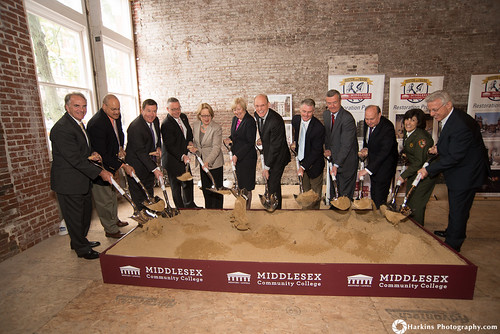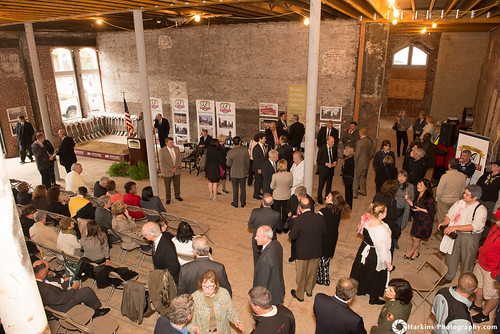Boston & Maine depot groundbreaking
Congratulations to yesterday’s groundbreaking by Middlesex Community College of the Boston & Maine Railroad Depot restoration project. I was not able to attend so MCC’s Pat Cook kindly sent some observations about the project and the event, along with some superb photos by Kevin Harkins. The following is by Pat Cook:
More than 150 community members turned out on Monday for a long-awaited groundbreaking at the historic Boston and Maine railroad depot at 240 Central St., as Middlesex Community College embarks on what is expected to be an 18-month construction project to convert the abandoned property into the college’s new academic and performing arts center.

Photo by Kevin Harkins
The building was built in 1876, but was abandoned decades ago before the Lowell National Historical Park stepped in, along with the Lowell Historic Preservation Commission, to help restore and preserve the property. Middlesex took the property over in 2008, and, with the help of an $11 million boost from the state higher education capital bond bill championed by the city’s State House delegation, and some federal study money, began the lengthy study and design of the building. Now, the college, which has come up with another $8 million to cover construction costs, is ready to begin the construction phase, which is sure to bring a buzz of activity to that end of the city’s JAM plan. The building serves as a gateway into the downtown, sitting atop the entrance to Central Street.
On Monday, the college tapped its new neighbors – Elliott’s Hot Dogs and Espresso’s Pizza – for the lunch menu at the packed event. Community members took tours of the property, and more than two dozen members of MCC’s theater department reprised their stage roles from some of their performances, including Batboy, Sweeney Todd, and Shakespeare’s Scottish Play (the real name of which can’t be used in the building because of theatrical superstition.)
Joining MCC President James Mabry on the program yesterday, along with the packed audience, were Congresswoman Niki Tsongas, Senate President Stanley Rosenberg, Senator Eileen Donoghue, State Representatives Thomas Golden and David Nangle, Lowell Mayor Rodney Elliott, Lowell City Manager Kevin Murphy, and Lowell National Historical Park Superintendent Celeste Bernardo.
The first floor and basement of the new building will house a new performing arts theater, as well as classrooms. The second floor will be home to dance and music performance spaces and classrooms. Design of the new egg-shaped theater was done by Leers-Weinzapfel, who also designed Harvard’s Hasty Pudding theater. Construction on the building will be performed by Consigli Construction.

Photo by Kevin Harkins
The building was built in 1876-1877. Designed in the high Victorian Gothic style, the building served as the Boston and Maine Railroad’s Central Street depot for the city of Lowell until 1895 when a new station was constructed nearby. It originally encompassed more than an acre of land. The depot consisted of a two-story brick head-house with a clock tower at the south end of the facade. Originally, the building played home to offices and other depot uses. Historic photographs indicate that express companies, printing offices, a tailor shop and the Western Union telegraph company leased space at the depot during the 1800s.
From 1895 until 1913, portions of the building were used as a cotton and wool storehouse. In 1913 the Boston and Maine Railroad company leased the building out for use as the Owl Theater, which became the Rialto theatre in 1920. In 1934, the building was foreclosed upon, and the new owner changed several structural facets of the building. In 1955, a portion of the building was destroyed by fire, and was subsequently torn down in the early 1960s. In the 1960s, the Rialto was converted into a bowling alley and a billiards parlor. Other occupants of the building included music teachers, barbers, florists, real estate agents, and a paint supply store. In the 1970s, the building served as Paul Tsongas’ congressional campaign office.
In 1984, more portions of the building were demolished, until the Lowell Historic Board stopped full demolition due to the building’s architecture. In 1989, the building’s owner donated the building to the Lowell Historic Preservation Commission, who in turn transferred ownership to the federal government.
Looking forward to seeing what the building will look like on the other side of the construction project.